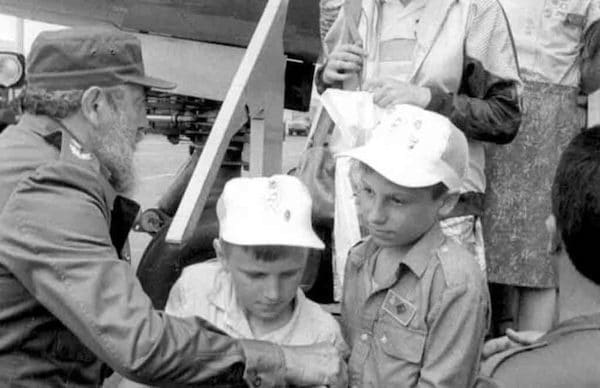On April 26, 1986, the explosion of a reactor at the Chernobyl plant produced a nuclear spill whose radiation contaminated 150 thousand square meters of what today are Ukraine, Belarus and Russia. Considered the worst nuclear accident in history, it was in many ways a slow-motion mishap. In addition to the 30 workers and rescuers who perished in the hours and days immediately after the explosion, hundreds of thousands of people were exposed to dangerous levels of radiation. Land, water, agriculture and livestock were contaminated. The number of deaths in subsequent decades remains in dispute. The lowest estimates are 4,000; others 90,000 and up to 200,000.
Several countries contributed resources, personnel and assistance to the recovery; the overwhelming majority went to contain and seal the reactor. In 1990, when the horror of the tragedy had ceased to be news, Cuba sent a medical team to evaluate the health consequences of the radiation. They found a situation in which cancer levels in children had increased 90 percent. The island would soon undertake medical assistance that is still difficult to measure: from 1990 to 2011, it cared for 26,000 people—22,000 children—from the affected area, covering medical, food, housing and recreational expenses for the minors and their companions.
The first 139 children from Chernobyl arrived on March 29, 1990 and were received by Fidel Castro. The images are touching, the President looks and greets the parents with attention and tenderly caresses the little ones. He promises them the best medical care.
The little ones from Chernobyl continued to arrive for more than two decades. Tarará, a city 20 kilometers from Havana, was selected to take care of them. Located on the seashore, before the revolution it was a vacation destination for the upper middle class. The revolutionary government transformed it into a youth summer camp. In 1990 it was adapted to care for the children of Chernobyl. In addition to having two hospitals and a clinic, the camp had a dining hall, recreational and cultural spaces, school, theater and parks.
“It wasn’t like being in a hospital,” recalls Roman Gerus who was in Tarara as a child, “even the sickest children had a good time.” Khrystyna Kostenetska, who was also treated there, describes,
I remember an incredible sea, waves, sunsets, nature and ice cream; I also remember children with serious health problems.
Upon arrival in Cuba, the children were evaluated by doctors organized into four categories: the most serious ones with oncohematological problems that required specialized therapies; those suffering from chronic pathologies; children who could be treated on an outpatient basis; and the relatively healthy ones who required medical follow-up because they had lived in the contaminated area. All were treated under the comprehensive logic of the Cuban medical system, whose teams included pediatricians, oncologists, psychiatrists and dentists. Sometimes ailments unrelated to the spill were detected and treated as well.
This Cuban initiative, which has been characterized as the longest humanitarian program in history, took place during one of the most difficult times for Cuba. The disintegration of the USSR in the early 1990s had eliminated its main trading partner and the island’s economy suffered a brutal contraction. Everything was in short supply except solidarity.
When historian John Kirk—whose book Public Health Without Borders provides a detailed account of the island’s care for the Chernobyl children—asked the director of the medical program in Tarará how Cuba could offer such help in such difficult times, he replied,
These are children, very sick children. How could we not treat them?
Several of the children who arrived were orphans and many others were poor. The disintegration of the Soviet Union meant the end of its social care infrastructure. The incipient capitalist system put a price tag on treatment that many could not afford. In addition to suffering from physical ailments, many lived with the trauma of having been evacuated from their homes. And the question remained as to what ailments would develop in the future and in other generations.
Xenia Laurenti, deputy director of the Chernobyl Children’s Health Care Program, states bluntly: “If you ask a Ukrainian child what he or she would like, the answer is not ‘toys’, but ‘health’. This is psychologically built in. And part of the program is aimed precisely at psychological rehabilitation, at not rejecting any kind of pathologies. Our goal is to cure.
No price can be put on this effort to heal. In 2010, a Ukrainian NGO tried to do so, calculating it at more than 300 million dollars for Cuba’s medical expenses alone. The testimonies of parents who, years later, between tears and smiles, express their gratitude to the Cuban people for the care they gave children, best capture the human dimension.
This is not just medical help—expressed one mother—it is a very great moral help for my people.
It was, like so many other initiatives of the Cuban revolutionary government, an unparalleled globalization of solidarity.
Tanalís Padilla is a professor-researcher at the Massachusetts Institute of Technology. Author of the book Unintended Lessons of Revolution, a history of the rural teacher training colleges.
Source: La Jornada , translation Resumen Latinoamericano—US

